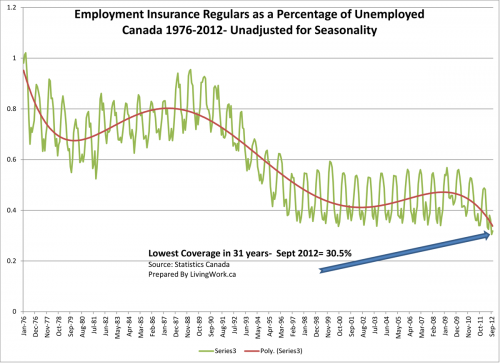New historical lows in EI coverage
This  is a guest post by Paul Tulloch on the deterioration of Employment Insurance coverage, also responding Statscan’s release of EI figures for October 2012.
The painful toll that job loss and unemployment can unleash on Canadian families has traditionally been managed with Canada’s once quite functional Employment Insurance (EI) program. However, today’s Statistics Canada’s EI report for October, confirms that government policy have produced new lows in Employment Insurance coverage of the unemployed.
Last month’s report showed that September coverage fell to a new historical low of 30.5%. Some speculated that it was an aberration, but today’s October report confirms that we have indeed entered an new era as the rate of EI coverage for the unemployed came in at a mere 31.8% , the second lowest in more than 30 years (seasonally unadjusted). The trend is clear in the data ( see graph) as we are witnessing the destruction of a once effective social safety net. There are strong seasonal factors in EI claims, but the trend line in the chart below clearly shows we are sinking to new lows in coverage for this program.
The official Statistics Canada numbers estimated that October’s EI regular beneficiaries increased by 4,600 to 535,000 or 0.9% from September. Given the stubbornly high unemployment counts of over 1.3 million people following the recession, this produces an EI coverage rate for the unemployed for both September and October of 30.5% and 31.8%. These are the two the two lowest rates recorded for at least 30 years.
Policy makers have been hacking and slashing away at worker income protection afforded by EI program for the last 10 years and the result is a new high in dysfunction. It is getting so bad, that potentially another name change is needed. The EI program in policy circles is known as a labour market adjustment mechanism, as it was originally designed to help those in the nasty jaws of unemployment successfully transition and find new work. However, it is difficult to call such a program an insurance system if a mere 30.5 % of the unemployed are collecting Employment Insurance benefits. It is mean spirited and whole lot more difficult for a family and to make such life changes with no help from government. Unemployment is indeed one of life’s more hectic and complicated changes with unquantifiable social costs. In terms of economic efficiency and the demands of a modern economy, one requires a functional EI program to help people with job searches, and skills matching. We have one of most educated workforces in the world, and when there are skills and job demands that require matching; time for successful job searches can become more complicated and time focused.
We also have a large population of the workforce employed in more seasonally affected work which automatically includes employment breaks and the possibility of transition periods due to the ups and downs of the economy. This is especially more critical as we become a more resource extraction based economy that has high concentrations of seasonal industries.
So as we pass into the holiday season, Harper’s cuts to EI will continue to heap more pain on Canadian workers as what was once quite useful and efficient program becomes a shell of itself.  And imagine this during what some have labeled the “great recessionâ€. Policy makers keep waiting for the great lift off, out of this stagnation, but with labour market dysfunction like this, it is little wonder why we cannot reach critical velocity.


It should be remembered, that this starving off, of the public’s economic safty net, begun with the Liberals. Are they shedding any tears?.
I had a couple questions regarding the math- I should clarify something- the numbers reported above, i.e. 535,00 regular EI recipients are seasonally adjusted. (which handy for doing trends, I guess) but not very handy for when figuring out the actual level of the ratio for coverage during said month.
So here are the numbers I used to calculate the EI coverage ratios which are the actual rates reported in that period , not seasonally abused-
September 387,240 EI recipients / 1,271,000 unemployed = 30.5%
and for October 403,620 recipients/ 1,267,900 unemployed =31.8%
If you want to do some trend analysis on the ratio, calculate the ratio with the real unadjusted EI and LFS data and then seasonally adjust the ratio.
Paul
Great blog, Paul!
I have a client that employs a person over 65 years of age. Would they be eligible to collect EI?
Karl
Cannot collect EI too old must be less than 65. However, if the worker is still working at 65 and beyond they still must pay EI premiums.
Not sure about how that works with the new 65-67 age elevation for qualification to OAS.
Precisely because of the looming change to age 67 OAS entitlement, we need to get this last EI point right. More workers will want to know their post-age 65 rights. It’s no longer true that you can’t collect EI after age 65. The rule changed quite a few years ago. You can collect EI after age 65 provided you meet all the usual rules (premium payer, available and looking for work, out of work due to layoff/sick leave/parental leave…hey, there’s a few older new dads, right?) Just remember:
(1) Service Canada may monitor you more closely to make sure you’re actually looking for work and not really retired from the labour force;
(2) EI will allocate any employment-based pension income (CPP/QPP, workplace pension etc but not OAS) to offset some or all EI benefits, depending on the amount.